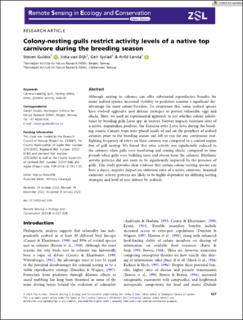Colony-nesting gulls restrict activity levels of a native top carnivore during the breeding season
Peer reviewed, Journal article
Published version

Åpne
Permanent lenke
https://hdl.handle.net/11250/3092452Utgivelsesdato
2023Metadata
Vis full innførselSamlinger
- Publikasjoner fra CRIStin - NINA [2364]
- Scientific publications [1392]
Sammendrag
Although nesting in colonies can offer substantial reproductive benefits formany seabird species, increased visibility to predators remains a significant dis-advantage for most colony-breeders. To counteract this, some seabird specieshave evolved aggressive nest defense strategies to protect vulnerable eggs andchicks. Here, we used an experimental approach to test whether colony inhabi-tance by breeding gullsLarusspp. in western Norway impacts visitation rates ofa native, mammalian predator, the Eurasian otterLutra lutraduring the breed-ing season. Camera traps were placed inside of and on the periphery of seabirdcolonies prior to the breeding season and left to run for one continuous year.Sighting frequency of otters on these cameras was compared to a control regionfree of gull nesting. We found that otter activity was significantly reduced inthe colonies when gulls were incubating and rearing chicks, compared to timeperiods when gulls were building nests and absent from the colonies. Rhythmicactivity patterns did not seem to be significantly impacted by the presence ofgulls. This study provides clear evidence that certain colony-nesting species canhave a direct, negative impact on visitation rates of a native carnivore. Seasonalcarnivore activity patterns are likely to be highly dependent on differing nestingstrategies and level of nest defense by seabirds. Camera trapping, gulls, nesting colony,otters, predator activity, seabirds
